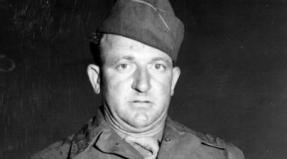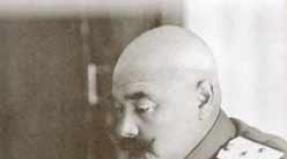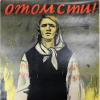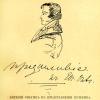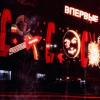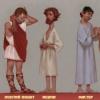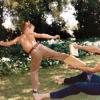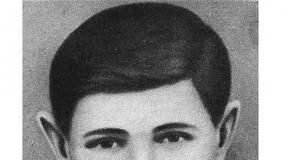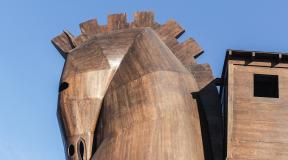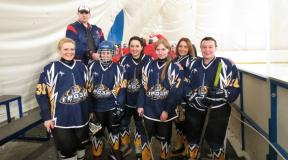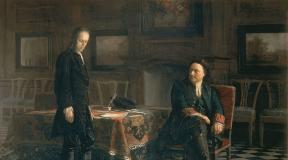Posters on the theme of the Great Warm. The most famous military posters. Photo
During the war, the poster was the most affordable type of visual art. Cream and clear, it displaced the whole essence immediately.
Posters strengthened the fighting spirit of soldiers. Clause to conscience and honor, courage and courage. And after many years, people, far from the war, when looking at the image, it does not have to reflect on the meaning of the drawn.The so-called TASS windows were extremely popular. These are posters that were replicated manually by transferring images with stencils, and were aimed at raising the combat spirit of soldiers, committing labor feats by the population. This type of agitation allowed to instantly respond to the events. Images were obtained more colorful compared to printed posters. When working with windows, contrasting colors were used, brief sharp phrases that "painted as shells".
In the poster art of the Great Patriotic War, several popular motives were traced.
The first motive - Until the last patron! Call on death, take care of the cartridges, shoot exactly in target. Since it is known for certain that the metal for weapons was given to the very large difficulty of the rear workers. Most often, the central figure on such posters was the personality of the fighter, the features of the person who crashed into memory for a long time.
Another popular was called Attack!" On posters with this motive, a military equipment was depicted - T-35 tank, aircraft, PE-2. Sometimes a legendary hero, commander of past years or heroes were depicted.
Also widespread was the motive about boyetse, defeatyurschool Enemia in hand-to-hand combat.On these posters, the soldiers of the Red Army was depicted in red, and the fascist - gray or black.
It is widely known to use caricatures In posters. Sometimes, not only the enemy itself, but also the destructiveness, the inhumanity of his actions was ridiculed. It is noteworthy that artists who worked on the image always very accurately noticed the character, habits, gestures, distinctive features of the characters depicted. For such a fine impact on the souls of people through a poster, not only a long-standing work on the study of the German newsreel, photos of Hitler, Goebbels, Geering, Himmler and others, but also the skill of a psychologist.
No less popular was the motive Death of detebians.At such posters, suffering was usually depicted, or the death of children, calls for help and protection.
Motive Do not talk!call for vigilance local population.
He sounded a call for the population for collecting scrap metal, to work without absenteeism, collect harvest to the last grain, bring the victory with every blow of the hammer.
With respect to posters, paintings and images, it is better to see once than a hundred times to read their description. We offer you the most famous posters of the Times of the Great Patriotic War 1941-1945.
Posters of the Great Patriotic War 1941-1945
Text on poster: Conquest peace! Kabala nations! - Fascist rate. Red Army Amendment!
Artist, year: Victor Denis (Denisov), 1943
The main motive: caricature
Summary: The excessive self-confidence of Hitler was ridiculous. The fighters of the Red Army tried to remove the fear of the enemy, depicting Hitler funny and ridiculous.

Poster text:Avenge!
Artist, year:Schmarinov D., 1942
The main motive:Death of detebians
Summary:The poster raises the subject of the sufferings of Soviet citizens in the occupied territories. On a poster, a woman holding a killed daughter in his hands is depicted. The suffering and grief of this woman is silent, but so touching. In the background poster glow from a fire. One word "avenge" raises the storm of indignation and malice to the fascist barbarians.

Poster text:Dad, kill the German!
Artist, year:Nesterova N., 1942
The main motive:Death of detebians
Summary:The poster referred to the suffering of the people in the occupied territories.He caused the hatred of hatred of the enemy, which encroached the most holy - women and children.The slogan on the poster was put on the phrase from the poem of Konstantin Simonov "Kill him!"

Poster text:Bay so: that neither the projectile, then the tank!
Artist, year:VB Koretsky, 1943
The main motive:To the last cartridge!
Summary:A poster calls on the soldier to improve his combat skill.

Poster text:The fighter, which was surrounded, boil to the last drop of blood!
Artist, year:HELL. Cocosh, 1941
The main motive:Fighter, winning the enemy in hand-to-hand combat
Summary:Called to stand on death, beat out of the last forces.

Poster text:Death of German fascist invaders!
Artist, year:N.M.Avvakumov, 1944
The main motive:Attack!
Summary:Poster called fighters selflessly go into battle,attack . In the background, tanks and airplanes are depicted, which rapidly rush against enemies. This is a kind of symbol that all the forces are focused on the fight against the Germans, that the Soviet soldier goes to battle all military equipment, inspiring the fascist and confidence with the Soviet fighters.

Poster text:So now the German beast looks like! So that we breathe and live - the beast! (on the drum - a lightning war, behind the belt - the extermination of the Slavs, on the flag - total mobilization)
Artist, year:Victor Denis (Denisov), 1943
The main motive:Caricature
Summary:The artist in a caricature form depicts a broken, explored German-beast. A broken German seems to see all his slogans with which he so self-attached to Russia. The author, putting the German funny and pitiful, tried to add courage and remove the fear of the soldiers.

Poster text:To Moscow! Hoh! From Moscow: Oh!
Artist, year:Viktor Denis (Denisov), 194 2
The main motive:Caricature
Summary:The poster is dedicated to the Great Battle for Moscow and the failure of the Plan of Lightning War (Blitzkrieg).

Poster text:Mother's mother call! (Text of the military oath)
Artist, year:I. Tidze, 1941
The main motive:Attack!
Summary:Artist R. aspans on the plane of the sheet, a holistic monolithic silhouette, uses a combination of only two colors - red and black. Thanks to the lowly taken horizon, monumentality is dodged. But the main power of the impact of this poster is enclosed in the psychological content of the image itself - in the expression of an excited face of a simple woman, in her urgent gesture.

Poster text:Do not talk! Be on the check, the walls light on such days. Not far from the chatter and gossip to the treason.
Artist, year:Vatolina N., Denisov N., 1941
The main motive:Do not talk!
Summary:Before the start of the Great Patriotic War and in its years, there were many sabotage groups and spies of Germany in the Soviet Union, especially in the border regions. These groups carried out various sabotage actions - violations and cliffs of power lines and communications, the destruction of important military and civilian objects, violation of water supply in the cities and destruction of wooden bridges, as well as the murder of military and party workers and technical specialists. These days, the task of bringing to the attention of the population The need to abide care and vigilance in conversations and communication, especially with unfamiliar.

Poster text:Comrade! Remember that well and warmly dressed fighter will even stronger the enemy.
Artist, year:A. and V. Kokorakins, 1942
The main motive:Everything for the front, all for victory
Summary:A poster encourages to mobilize all the means of the population and give all the most necessary soldiers who fight for their homeland.

Poster text:Red Army Grozen Step! Will be destroyed in the lair's enemy! Conquesting the world. Slavery to nations. Fascism. Hitler, Goering, Goebbels, Gimler.
Artist, year:Victor Denis (Denisov), 1945
The main motive:Attack! Caricature.
Summary:A poster makes you think about the atrocities of the German fascism against humanity.

Poster text:Victory will be in the country where a woman with a man is along. Comrade woman! Your son on the front beats like a hero. And the daughter goes to the squad of Rockka. And you crippy our rear: a trench deeper by swarm, go to the machine. And the tractor of his leads instead of drivers, now leading tanks. You, sisters women! You, Mother Citizens! Take scrap, shovel, steering wheel, cutter! For realunderstand, finally, the stronger the rear - the harder the armies step, and the sooner the enemy will die!
Artist, year:I. Astapov, I. Kholodov, 1941
The main motive:Everything for the front, everything for victory!
Summary:A poster carries political color to the superiority of society, where men and women are equal, especially during the war, when men are fighting on the fronts, women ensure the reliability of the rear.

Poster text:Blood for blood, death for death!
Artist, year:Alexe Sittaro, 1942
The main motive:Death of detebians; Attack!
Summary:The poster is aimed at suggesting the inevitability of victory over the enemy and its full exile from the Soviet Earth.

Poster text:Bay to death!
Artist, year:Nikolay Zhukov, 1942
The main motive:To the last cartridge!
Summary:About marriage To the warriors of the Red Army, strongly beat the enemy for the sake of salvation mothers, children and homeland.A poster is designed to raise the morale soldiers.

Poster text:Warrior of the Red Army, save!
Artist, year:Viktor Koretsky, 1942year
The main motive:Death of detebians
Summary:The poster caused hatred to the enemy's fighters.The dramatic strength of this poster amazes to this day. The most difficult stage of war for the Russian people was reflected in the work of Koretsky. The ancient motive is a mother with a child in her arms - gets in a poster completely different interpretation than we are accustomed to see in the pictures of the masters of the past. In this paper, there are no idyllic features, heartiness and warmth, which is usually present in scenes with mother and child, here the mother is depicted by protecting his child from danger. On the one hand, in the poster we see an unequal collision of the two forces: cold, bloody weapons on the one hand, and two defenseless human figures - on the other. But at the same time, the poster does not produce an oppressive impression, due to the fact that Koretsky could show the power and the deep right point of the Soviet woman, despite the fact that there is no weapon in her hands, she symbolizes the strength and spirit of the Russian people who will not be bowed to the aggressor . With his protest against violence and death, the poster announces the coming victory. With the help of simple means, the work of Koretsky inspires strength and confidence, becomes both a call, and a request, and order; So the danger hanging over people and never leaving their hope is expressed in it.

Poster text:There is no such force that would enslave us. Kuzma minin. Let them inspire you in this war, the courageous image of our great ancestors! I. Stalin.
Artist, year:V. Ivanov, O. Burova, 1942
The main motive:Attack!
Summary:A second symbolic plan is present on the poster, depicting the liberation of the Kuzma mini home from the intervention. Thus, even the great heroes of the past name is soldiers to fight and fight for their homeland.

Poster text:Combat menu by the enemy to each day.It begins in Russian treats with snacks. Patties are excellent with a start of different ...Then soups a little soup of the fleet and the okroshka. On the second Battle of Cakatski and Caucasian kebabs and sweets - Kisel.
Artist, year: N. Muratov, 1941
The main motive:Caricature
Summary:A poster is made in a satirical style and strengthens confidence in the victory of the Soviet people over the enemy.

Poster text:The enemy is cunning - be on a check!
Artist, year:V. Ivanov, O. Burova, 1945 year
The main motive:Do not talk
Summary:A poster calls for a lookout population and soldiers.The plot of the poster reminds that a fascist criminal can be hidden under a virtue.

Poster text:The TASS window No. 613 German to the Volga went to get drunk - Fritz's teeth on the teeth,
there was a nurse to be broken, - rolls side, spin hurts. It can be seen, the Volga womb for the fascist is not suitable, it is cold for Fritz, Solon!
Artist, year:P. Sargsyan
The main motive:Caricature
Summary:The poster emphasizes the idea that the Russian people invincible and the enemy will still be defeated.
In Soviet times, the posters were one of the most common means of mass agitation. With the help of posters, talented artists expressed the will of the people, called for certain actions, pointed to good and bad parties of life, brought up a sense of self-esteem in people, a sense of patriotism and love for their own country, their people. The posters of the USSR times concerned the most different parties to life and affected almost everything that happened in society. For all the time a giant number of posters were created, which condemn drunkenness, talk about the benefits of labor and sports, show life in good light in Russia and indicate the disadvantages of the West. However, the most bright, most important, deep, touching and even tragic are the posters of the times of the Great Patriotic War.
Soviet posters of times Great Patriotic War 1941-1945 Call all people of an immense country to oppose fascism. In the brightest and visual images, they show the whole horror of war and all the inhumanity of fascism, which decided to conquer the world. Posters during the war were one of the massive campaigning means, acting on a par with newspapers and radio. Many of these posters have become so famous that they are used even today and are considered real masterpieces of the art of a poster case. These posters can be touched on the heart, awaken special feelings even now, when many decades have passed after that terrible war, which claimed the lives of millions of soldiers and civilians.
Talented artists were engaged in the creation of campaign posters, the names of which remained in the history of the visual art of the Soviet period. The most famous artists of this genre were Dmitry Moor, Viktor Denya, Mikhail Cheremnyy, Tidza Irakli Moiseevich, Kokorekin Alexey Alekseevich, Ivanov Victor Semenovich, Koretsky Viktor Borisovich, group of artists "", group of artists "TASS windows" and others. In his art, they created the majestic, memorable and inspirational images, the tense plot, which appealed to sincere feelings, and also accompanied their works with bright phrases that were remembered and crashed into memory. Without a doubt, the art of a campaign poster contributed to the formation of a sense of patriotism of the people of that time, because no wonder propaganda and agitation was then called the Third Front of the Great Patriotic War.










The Great Patriotic War lasted 1418 days. In each of these days, thousands of events took place in thousands of seats. Covered and describe all these events are almost impossible - they all had different meanings. I decided to assemble the military campaign posters of those times
Poster Watolina N.N. "You are bravely fought with the enemy - enter, the owner, to the new home!". 1945 year
Poster V.Deni "The Red Army broom the evil sacrifted her dot!" 1945 year.

Poster Koretsky V.B. "We have one - Berlin!". 1945 year.

Poster Zhukova N.N. "We are waiting for you, my birthmark." 1945 year.

Poster Golovanova L.F. "We do to Berlin!". 1944 year.

Poster Ivanova V.S. and boring OK "All hope for you, a red warrior!". 1943.

Poster Gordon M.A. "We destroy the hated" new order in Europe "and kill its builders!". 1943.

Poster Koretsky V.B. "The Warrior of the Red Army, save!". 1942 year.

Poster V.B. Korotsky "Our forces are notishable!" 1941 year.

Poster Zhukova N.N. and Klimashina V.S. "I will pass Moscow!". 1941 year.

Poster V.Ivanova "For the Motherland, for the honor, for freedom!" 1941 year.

Poster I.Tidze "Motherland - Mother calls." 1941 year

Wait for me and I will come back.
Just wait very much
Wait for sadness
Yellow rains.
Wait, when the snow is sweeping,
Wait for the heat,
Wait, when others do not expect,
By changing yesterday.
Wait, when from long-distance places
Letters will not come.
Wait when you get bored
Everyone who is waiting together.
Wait for me and I will come back,
Do not regret the good
Everyone who knows by heart
What to forget it is time.
Let them believe the Son and Mother
That is not me,
Let friends be waiting to wait
Sit by fire
Get down bitter wine
On the soul member ...
Wait. And with them at the same time
Do not rush to drink.
Wait for me and I will come back
All deaths called.
Who did not wait for me, let him
Said: lucky.
Not to understand not waiting for them,
As among the fire,
His expectation
You saved me.
As I survived, we will know
Only we are with you
Simply, you knew how to wait
Like no one else.
Konstantin Simonov, West Front, June 1941


Where the grass from dew and the blood is raw,
where the pupils of machine guns fiercely look
in full growth over the front edge
the winner of the soldier rose.
The heart beat about the edges intermittently, often.
Silence - silence, not in a dream, in reality.
And said the infantryman: - Own! Basta!
And noticed a violet into the rocks.
And in the shower, gone for light and affection,
there was a joy of the former singeling stream.
And the soldiers bent, and to the ridiculous helmet
Carefully adjusted the flower.
Again came to life were alive
Moscow region under the snow, in the fire of Stalingrad.
For four unthinkable years, for the first time,
As a child, I cried the soldier.
So stood the infantryman, laughing and sobbing,
bunny trample a spiny woven.
Behind the shoulders of the burned dawn young,
foreshadowing a sunny day.
The soldiers were struggled on the fronts, partisans and scouts - in the occupied territory, and the tank workers collected tanks. Propagandists and artists turned pencils and brushes into weapons. The main task of the poster was the strengthening of the faith of Soviet people in victory. The first poster thesis (now they would be called a slogan) became a phrase from Molotov's speech on June 22, 1941: "Our business will be broken, the victory will be behind us." One of the main characters of the military poster was the image of a woman - mother, homeland, girlfriend, wives. She worked in the rear at the factory, collected a harvest, waited and believed.
"Ruthlessly defeat and destroy the enemy", Kukryniks, 1941
The first military poster, disclosed on the walls of the houses on June 23, was the list of artists of Kukryniksov, depicting Hitler, treacherously ruining the non-aggression pact between the USSR and Germany. ("Kukryniks" is three artists, the name of the team is made up of the initial letters of the names of Kupriyanov and the Wings, and the name and first letter of the name Nikolai Sokolov).

"Motherland name call!", Tidze Irakli, 1941
The idea of \u200b\u200bcreating a mother's image calling for helping his sons, arose by chance. Hearing the first message of Sovinformbüro about the attack of fascist Germany in the USSR, the spouse Tidza ran into his workshop with a cry of "War!". An expression of her face, the artist ordered his wife to stop and immediately began to make sketches of the future masterpiece. The impact on the people of this work and the song "Sacred War" was much stronger than the conversations of the political officers.

"Be a hero!", Viktor Koretsky, 1941
The slogan of the poster became prophetic: millions of people stood up for the defense of the Fatherland and defended their freedom and independence. In June 1941, Koretsky created the composition "Be Hero!". A poster, enlarged several times, was installed along Moscow streets, for which columns of mobilized residents of the city were held in the first weeks of war. In August of this year, the postage stamp "Be Hero!" Was released Both on the brand, and on the poster, the fighter infantryman is depicted in the SS-36 helmet helper. On the days of the war, the helmets were another form.

"Let's more tanks ...", Lazar Lisitsky, 1941
Beautiful work of an outstanding artist-avant-garde, illustrator of Lisitsky Lazarus. Poster "Let's more tanks ... Everything for the front! All for victory! " It was printed by many thousands of edition a few days before the artist's death. Lysitsky died on December 30, 1941, and the slogan "Everything for the front!" The whole war was the main principle of people remaining in the rear.

"The Warrior of the Red Army, save!", Viktor Koretsky, 1942
A woman crawling towards himself a child, ready to breast, his life to protect his daughter from a bloody bayonet of a fascist rifle. One of the most emotionally strong posters was issued a 14 millionth edition. Frontoviki saw their mother, wife, sister, and in a frightened defenseless girl, her mother, her future in a frightened defenseless girl, her future in a frightened defenseless girl.

"Do not talk!", Nina Watolina, 1941
In June, the 41st artist Watolina was offered to graphically arrange the famous lines of Marshak: "Be to the alert! On these days eaven the walls. Not far from the chatter and gossip to the treason, "and after a couple of days, the image was found. A model for work served a neighbor, with which the artist often stood in the same queue in bun. A strict face of an unknown woman has become one of the main symbols of the fortress country in the front of the fronts.

"All hope for you, a red warrior!", Ivanov, Burova, 1942
The topic of revenge in the invaders becomes leading in the work of plastic artists at the first stage of war. Instead of collective heroic images, the first place are published by persons resembling specific people - your girl, your child, your mother. Avenge, free, save. The Red Army retretched, and women and children left in the occupied enemy of the territory were silent from the posters.

"Musty for the mountain of the people!", Viktor Ivanov, 1942
The poster accompany the poems of faith inbert "Bay Enemy!", After reading which, perhaps, no longer needed any words ...
Bay enemy so he exhausted
So that he choke in the blood,
So that your blow has been equal to strength
All my maternal love!

"Fighter of the Red Army! You do not give your favorite shame ", Fyodor Antonov, 1942
The enemy was approaching the Volga, the huge territory was occupied, at which hundreds of thousands of civilians lived. The characters of artists became women and children. Posters showed trouble and suffering, calling for a warrior to overthrow and help those who are unable to help themselves. Antonov turned to the fighters on behalf of their wives and sisters with a poster "... You won't give your favorite to shame and dishonor to Hitler's soldiers."

"My son! You see a lot of my ... ", Antonov, 1942
This work has become a symbol of people's suffering. Maybe mom, there can be a depleted sacrificent homeland - an elderly woman with a knot in his hands, which leaves a burnt village. She as if she stopped for a second, sorely rushing, she asks for the help of his son.

"Warrior, answer the birthplace of the victory!", Dementy Shmarinov, 1942
The artist very simply revealed the main theme: Rodina Grow bread and gives the most perfect weapon in the hands of the soldier. Woman gathered automaton and gathered ripe ears. Red red banner color dress confidently leads to victory. Fighters must win, and the workers of the rear give more and more weapons.

"Tractor in the field that tank in battle", Olga Burova, 1942
The bright optimistic colors of the poster assure - the bread will be, the victory is not far off. Your women believe in you. The air battle goes away, Echelon passes with fighters, but the faithful girlfriends make their work, contributing to the case of victory.

"Red Cross Buligs! Do not leave on the battlefield or wounded, nor his weapons, "Viktor Koretsky, 1942
Here is an equal fighter, a nurse and a savory.

"We drink the water of the native Dnieper ...", Viktor Ivanov, 1943
After the victory in the Stalingrad battle, it was obvious that the advantage on the side of the Red Army. The artists now needed the creation of posters, which would show the meeting of the liberators of Soviet cities and villages. Successful forcing Dnieper could not stay away from artists.

"Glory to the liberators of Ukraine!", Dementy Shmarinov, 1943
Forcing the Dnieper and Liberation of Kiev is one of the glorious pages of the history of the Great Patriotic War. Mass heroism was adequately appreciated, and 2438 people were awarded the title of Hero of the Soviet Union. For the forcing of the Dnieper and other rivers, for the senses performed in the subsequent years, the title of Hero of the Soviet Union received another 56 people.

"Get up in the ranks of the front-line girlfriends ...", Victor Koretsky, VeraGutsevic, 1943.
The front required reinforcement and female forces.

"You have returned life to us," Viktor Ivanov, 1944
So they met the soldier of the Red Army - as a native, as a liberator. Woman without holding back gusting gratitude, hugs a stranger soldier.
.jpeg)
"Europe will be free!", Viktor Koretsky, 1944
By the summer of 1944 it became clear that the USSR could not only expel the enemy from their land, but also to release the peoples of Europe and complete the defeat of the Hitler's army. After the opening of the second front, the topic of the joint struggle of the Soviet Union, Great Britain and the United States for the liberation of the entire Europe from the "brown plague" became relevant.

"We have one sight - Berlin!", Viktor Koretsky, 1945
It remains very little. The goal is close. No wonder, a woman appears next to the soldier on the poster - as a promise that they will soon be able to see.

"Received Berlin", Leonid Golovanov, 1945
Here is the long-awaited victory ... Spring posters of 1945 breathe in spring, peace, great victory! Behind the hero, Leonid Golovanov's poster is visible "I will reach Berlin!", Published in 1944, with the same main character, but so far without an order.

"Wait", Maria Nesterova-Berzina, 1945
Frontoviki returned home with the consciousness of their dignity of people who have fulfilled their duty. Now the former soldier will have to restore the farm and establish a peaceful life.
Father Hero-Son met
and her husband hugged his wife,
and watch with admirable children
on combat order.
.jpg)
And we also live in wartime! And today our country is occupied by the enemy, it is plunder. Russian culture is destroyed, the People's Spirit is replaced by ribia, conscience is driven underground.
Yes, today is the military time. War, truth, the other. Then it was clear: who is the enemy and where he is. Today the enemy does not climb into our land with machine guns, tanks and guns. It uses other methods and puts longer goals than a simple military occupation.
Nowadays, the enemy uses weapons less catchy, almost imperceptible, but not less effective. A Russian man, as it is already in the West in the West, - trying to determine, change his essence, deprive the spiritual support, expel the conscience from his soul and leave only the human shell, ideally fought by gadgets. For ease of management and slow but steady kill. Impact through the soul and genes for future generations, which, according to the environment of the enemy, should not be born at all.
But we remember and honor the exploits of our ancestors. Who give us strength and confidence that we will drive the enemy from the land of Russian and celebrate the victory over the sacuost, in whatever do it is neglected!
Our right thing, we will win!
The soldiers were struggled on the fronts, partisans and scouts - in the occupied territory, and the tank workers collected tanks. Propagandists and artists turned pencils and brushes into weapons. The main task of the poster was the strengthening of the faith of Soviet people in victory.
The first poster thesis (now they would be called a slogan) became a phrase from Molotov's speech on June 22, 1941: "Our business will be broken, the victory will be behind us." One of the main characters of the military poster was the image of a woman - mother, homeland, girlfriend, wives. She worked in the rear at the factory, collected a harvest, waited and believed.
"Ruthlessly defeat and destroy the enemy", Kukryniks, 1941
The first military poster, disclosed on the walls of the houses on June 23, was the list of artists of Kukryniksov, depicting Hitler, treacherously ruining the non-aggression pact between the USSR and Germany. ("Kukryniks" is three artists, the name of the team is made up of the initial letters of the names of Kupriyanov and the Wings, and the name and first letter of the name Nikolai Sokolov).
"Motherland name call!", Tidze Irakli, 1941
The idea of \u200b\u200bcreating a mother's image calling for helping his sons, arose by chance. Hearing the first message of Sovinformbüro about the attack of fascist Germany in the USSR, the spouse Tidza ran into his workshop with a cry of "War!". An expression of her face, the artist ordered his wife to stop and immediately began to make sketches of the future masterpiece. The impact on the people of this work and the song "Sacred War" was much stronger than the conversations of the political officers.
"Be a hero!", Viktor Koretsky, 1941
The slogan of the poster became prophetic: millions of people stood up for the defense of the Fatherland and defended their freedom and independence. In June 1941, Koretsky created the composition "Be Hero!". A poster, enlarged several times, was installed along Moscow streets, for which columns of mobilized residents of the city were held in the first weeks of war. In August of this year, the postage stamp "Be Hero!" Was released Both on the brand, and on the poster, the fighter infantryman is depicted in the SS-36 helmet helper. On the days of the war, the helmets were another form.
"Let's more tanks ...", Lazar Lisitsky, 1941
Beautiful work of an outstanding artist-avant-garde, illustrator of Lisitsky Lazarus. Poster "Let's more tanks ... Everything for the front! All for victory! " It was printed by many thousands of edition a few days before the artist's death. Lysitsky died on December 30, 1941, and the slogan "Everything for the front!" The whole war was the main principle of people remaining in the rear.
"The Warrior of the Red Army, save!", Viktor Koretsky, 1942
A woman crawling towards himself a child, ready to breast, his life to protect his daughter from a bloody bayonet of a fascist rifle. One of the most emotionally strong posters was issued a 14 millionth edition. Frontoviki saw their mother, wife, sister, and in a frightened defenseless girl, her mother, her future in a frightened defenseless girl, her future in a frightened defenseless girl.
"Do not talk!", Nina Watolina, 1941
In June, the 41st artist Watolina was offered to graphically arrange the famous lines of Marshak: "Be to the alert! On these days eaven the walls. Not far from the chatter and gossip to the treason, "and after a couple of days, the image was found. A model for work served a neighbor, with which the artist often stood in the same queue in bun. A strict face of an unknown woman has become one of the main symbols of the fortress country in the front of the fronts.
"All hope for you, a red warrior!", Ivanov, Burova, 1942
The topic of revenge in the invaders becomes leading in the work of plastic artists at the first stage of war. Instead of collective heroic images, the first place are published by persons resembling specific people - your girl, your child, your mother. Avenge, free, save. The Red Army retretched, and women and children left in the occupied enemy of the territory were silent from the posters.
"Musty for the mountain of the people!", Viktor Ivanov, 1942
The poster accompany the poems of faith inbert "Bay Enemy!", After reading which, perhaps, no longer needed any words ...
Bay enemy so he exhausted
So that he choke in the blood,
So that your blow has been equal to strength
All my maternal love!
"Fighter of the Red Army! You do not give your favorite shame ", Fyodor Antonov, 1942
The enemy was approaching the Volga, the huge territory was occupied, at which hundreds of thousands of civilians lived. The characters of artists became women and children. Posters showed trouble and suffering, calling for a warrior to overthrow and help those who are unable to help themselves. Antonov turned to the fighters on behalf of their wives and sisters with a poster "... You won't give your favorite to shame and dishonor to Hitler's soldiers."
"My son! You see a lot of my ... ", Antonov, 1942
This work has become a symbol of people's suffering. Maybe mom, there can be a depleted sacrificent homeland - an elderly woman with a knot in his hands, which leaves a burnt village. She as if she stopped for a second, sorely rushing, she asks for the help of his son.
"Warrior, answer the birthplace of the victory!", Dementy Shmarinov, 1942
The artist very simply revealed the main theme: Rodina Grow bread and gives the most perfect weapon in the hands of the soldier. Woman gathered automaton and gathered ripe ears. Red red banner color dress confidently leads to victory. Fighters must win, and the workers of the rear give more and more weapons.
"Tractor in the field that tank in battle", Olga Burova, 1942
The bright optimistic colors of the poster assure - the bread will be, the victory is not far off. Your women believe in you. The air battle goes away, Echelon passes with fighters, but the faithful girlfriends make their work, contributing to the case of victory.
"Red Cross Buligs! Do not leave on the battlefield or wounded, nor his weapons, "Viktor Koretsky, 1942
Here is an equal fighter, a nurse and a savory.
"We drink the water of the native Dnieper ...", Viktor Ivanov, 1943
After the victory in the Stalingrad battle, it was obvious that the advantage on the side of the Red Army. The artists now needed the creation of posters, which would show the meeting of the liberators of Soviet cities and villages. Successful forcing Dnieper could not stay away from artists.
"Glory to the liberators of Ukraine!", Dementy Shmarinov, 1943
Forcing the Dnieper and Liberation of Kiev is one of the glorious pages of the history of the Great Patriotic War. Mass heroism was adequately appreciated, and 2438 people were awarded the title of Hero of the Soviet Union. For the forcing of the Dnieper and other rivers, for the senses performed in the subsequent years, the title of Hero of the Soviet Union received another 56 people.
"Get up in the ranks of the front-line girlfriends ...", Victor Koretsky, VeraGutsevic, 1943.
The front required reinforcement and female forces.
"You have returned life to us," Viktor Ivanov, 1944
So they met the soldier of the Red Army - as a native, as a liberator. Woman without holding back gusting gratitude, hugs a stranger soldier.
"Europe will be free!", Viktor Koretsky, 1944
By the summer of 1944 it became clear that the USSR could not only expel the enemy from their land, but also to release the peoples of Europe and complete the defeat of the Hitler's army. After the opening of the second front, the topic of the joint struggle of the Soviet Union, Great Britain and the United States for the liberation of the entire Europe from the "brown plague" became relevant.
"We have one sight - Berlin!", Viktor Koretsky, 1945
It remains very little. The goal is close. No wonder, a woman appears next to the soldier on the poster - as a promise that they will soon be able to see.
"Received Berlin", Leonid Golovanov, 1945
Here is the long-awaited victory ... Spring posters of 1945 breathe in spring, peace, great victory! Behind the hero, Leonid Golovanov's poster is visible "I will reach Berlin!", Published in 1944, with the same main character, but so far without an order.
Natalia Kalinichenko

